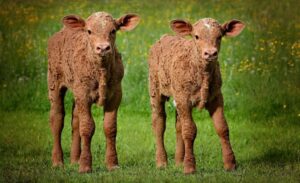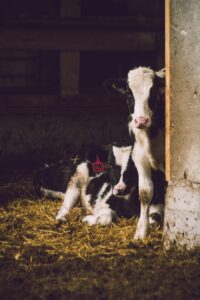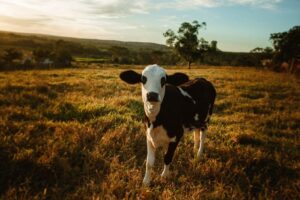
A road trip of a lifetime: when bobby calves go to slaughter
Dit artikel is een opdracht i.h.k.v. mijn opleiding Animal Welfare Science, Ethics and Law.
Every day the dairy industry sends newborn calves to the slaughterhouse, in an attempt to satisfy our appetite for cheese, yoghurt, butter, chocolate, ice cream and other ‘milky delicacies’. The road towards their final destination can be so stressful and exhausting for these young animals, that they might already be dead upon arrival. It’s an unfortunate and cruel price to pay for our ever-increasing demand for dairy products.
All year round dairy cows provide us with large quantities of milk. Like humans and other mammals, they can only give milk after giving birth. To avoid calves drinking it, mother and offspring are separated only a few hours or days after birth. A stressful experience for both. Once separated, newborns will put their heads out of the pen. They’ll start calling on their mother, hoping to see her again ¹, which never happens.
Bobby calves

What will happen next is mostly determined by gender. If ‘lucky’, female calves will grow up to become dairy cows themselves. But not all offspring and certainly not male calves are useful. These bobby calves – as they are referred to – are by far the biggest victims of the dairy industry. They are as useless as male chicks in the egg industry. These ‘surplus’ calves are born, only to make sure that cows can produce enough milk to keep dairy consumers happy.
So, what to do with bobby calves? Well, there are a few options. The calves can be killed on the farm, straight after birth or a few days later. Farmers can sell them to be raised for meat, or they can be sent off to the slaughterhouse. Although all options are stressful, transporting calves of just a few days old can cause lasting traumas or even death. These young animals can undergo so much discomfort, that their first and probably last journey can evoke increased incidences of morbidity and mortality ².
Stress factors
There are several factors that influence the stress levels of calves being transported ³:
- air quality in the vehicle
- loading and unloading
- driving performance

The trailer environment has a significant influence on the welfare of animals and certainly on bobby calves being transported. When these newborn animals have to go through a delay of hours or even days, the consequences can be horrible. Mortality of calves increases considerably with distance and time ⁴.
When the temperature within the vehicle can’t be regulated, the calves might experience both heat stress and cold stress ⁵. During summer, the outside temperature can even have more effect on the trailer environment than the loading density ⁶. Both over- and underloading transport trucks will affect the welfare of the animals, causing bruises, injuries and other inconveniences. Appropriate loading densities under varying environmental and seasonal conditions are required, to ensure better welfare ⁷.
No food or water
Most calves hit the road without having access to water or food. Considering the age of bobby calves, the lack of these vital resources can cause even more suffering, especially during longer transports and ongoing delays. Several studies reveal that fastening for 12, 24, 48, and 96 hours can cause weight losses of 6, 8, 12, and 14%, respectively ⁷. The amount of weight loss in calves is proportionately greater than the weight reduction in lambs and adult cattle ⁸.
To prevent delays or more inconveniences during the trip, it is important that the transport is carried out by experienced drivers, who can recognize and manage risks like road conditions, weather-related road closures, construction and detour routes ⁹.
Handlers also play a crucial role in the whole process. Loading and unloading crews working long hours can become impatient or even a bit reckless, certainly when they have to deal with bobby calves. These animals are hardly old enough to stand properly on their feet and certainly didn’t get the time to learn following behaviour, which makes handling them more difficult ¹⁰.
Stressful ending

The experience of loading and unloading is the most stressful part of the whole trip. It causes more frustration than the effect of the transport itself ¹¹. Age and weight are important factors to manage transport stress. Young calves lack both, which is why they suffer more compared to older animals ¹². Handling them with care can therefore prevent more unnecessary discomfort.
When bobby calves aren’t killed on the day when they arrive at the slaughterhouse, the risk of mortality will increase before slaughtering can even take place the next day ¹³. And that’s when it all ends.
After a few stressful and nerve-racking days on earth, these beautiful animals are reduced to pet food, leather purses or by-products for the pharmaceutical industry. A big sacrifice for our daily dairy needs.
References
- Weary, D.M. and Chua, B. (2000) Effects of early separation on the dairy cow and calf: 1. Separation at 6 h, 1 day and 4 days after birth. Applied Animal Behaviour Science, 69(3), 177-188. doi: 10.1016/S0168-1591(00)00128-3
- Fike, K. and Spire, M.F. (2006) Transportation of Cattle. Veterinary Clinics of North America. Food Animal Practice, 22(2), 305-320.
- Malena M., Voslářová, E., Kozák, A., Bělobrádek, P., Bedáňová, I., Steinhauser, L., Večerek, V. (2007) Comparison of mortality rates in different categories of pigs and cattle during transport for slaughter. Acta Veterinaria Brno, 76(8), 109-116. doi: 10.2754/avb200776S8S109
- Cave, J.G., Callinan, A.P.L., Woonton, W.K. (2008) Mortalities in bobby calves associated with long distance transport. Australian Veterinary Journal, 83(1-2), 82-84. doi: 10.1111/j.1751-0813.2005.tb12203.x
- Mitchell, M.A. and Kettlewell, P.J. (2008) Engineering and design of vehicles for long distance road transport of livestock (ruminants, pigs and poultry). Veterinaria Italiana 44(1), 201-213.
- Goldhawk, C., Janzen, E., González, L. A., Crowe, T., Kastelic, J., Pajor, E., Schwartzkopf-Genswein, K. S. (2014) Trailer micro-climate and calf welfare during fall-run transportation of beef calves in Alberta. Journal of Animal Science, 92(11), 5128–5140. doi: 10.2527/jas.2014-7960.
- Schwartzkopf-Genswein, K.S., Aloha, J., Edwards-Callaway, L. (2016) Symposium Paper: Transportation issues affecting cattle well-being and considerations for the future. The Professional Animal Scientist 32, 707–716. doi: 10.15232/pas.2016-01517
- Kirton, A.H. and Paterson, D.J. (1973) Effects of starvation before slaughter on some body components of bobby calves. New Zealand Journal of Experimental Agriculture, 1(2), 115-119. doi:10.1080/03015521.1973.10427629
- Schwartzkopf-Genswein, K.S., Haley, D.B., Church, S., Woods, J., O’Byrne, T. (2008) An education and training programme for livestock transporters in Canada. Veterinaria Italiana 44(1), 273-283.
- RSPCA Knowledge Base (2020) What happens to bobby calves? Available at: kb.rspca.org.au/knowledge-base/what-happens-to-bobby-calves/ [Accessed: 1 November 2020]
- Trunkfield, H.R. and Broom, D.M. (1990) The welfare of calves during handling and transport. Applied Animal Behaviour Science, 28(1–2), 135-152. doi: 10.1016/0168-1591(90)90050-N
- Grandin, T. (1997) Assessment of stress during handling and transport. Journal of Animal Science, 75(1), 249–257. doi: 10.2527/1997.751249x
- Boulton,A.C., Kells, N.J., Cogger, N., Johnson, C.B., O’Connor, C., Webster, J., Palmer, A., Beausoleil, N.J. (2020) Risk factors for bobby calf mortality across the New Zealand dairy supply chain. Preventive Veterinary Medicine, 174. doi: 10.1016/j.prevetmed.2019.104836
